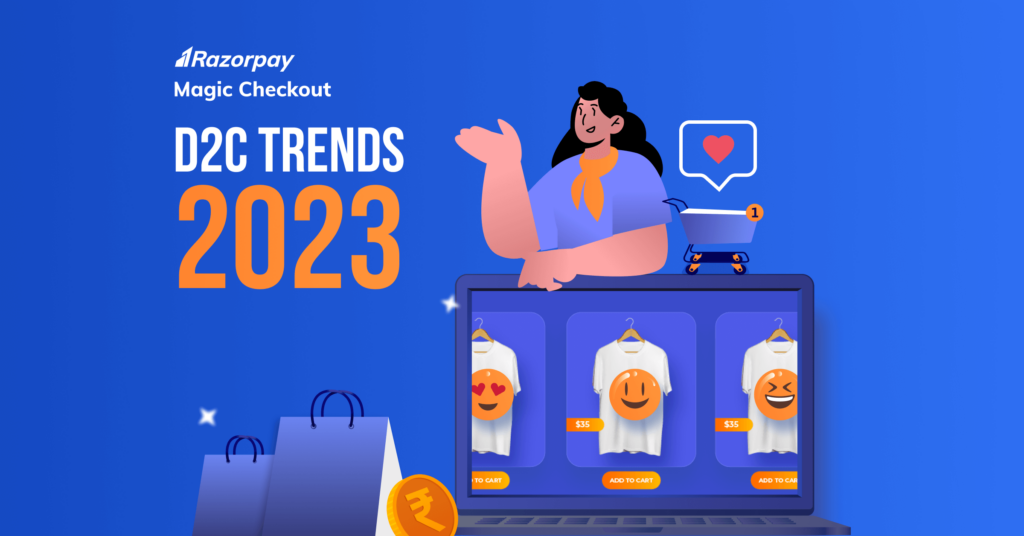India’s D2C industry is growing fast, with demands coming from Tier II and III cities, buoyed by interest among consumers to experiment with new brands. eCommerce/D2C has seen exponential growth in the last couple of years, and the pandemic has a considerable role to play in it. The pandemic pushed customers to shop online, contributing to more than Rs. 20-lakh-crore in sales worldwide.

Source: Inc42
As online shopping is growing, customer buying behavior is evolving as well. The D2C industry is already seeing a wave of changes, and adapting to these changes is a necessity. So let’s find out what D2C trends to expect in 2023 and beyond.
Hyper-Personalized Shopping

Hyper-personalization refers to providing a highly personalized shopping experience based on real-time behavioral data, AI, advanced analytics, and services, that are catered to individual aspirations and needs. With hyper-personalization, eCommerce stores can provide customers with a customized, targeted, and fine-tuned shopping experience.
Take Nykaa, for example. Nykaa, a marketplace, has launched a new feature called Routine Finder. It creates a customized routine for skin, hair, and overall wellness. SkinGenes Rx, another cosmetics company, offers targeted skincare programs based on the skin’s genetics. Another good example is Qua Nutrition, which suggests nutrition products after analyzing every individual’s health requirements.
Plugins like Visidea, WooCommerce 360º Image, Advanced Product Fields, and more can help you provide personalized shopping recommendations to your customers on WooCommerce. And for Shopify, you can try Product Customizer App, Qstomizer App, and Zepto Product Personalization App.
Don’t miss the D2C event of the year—Sign up for Razorpay D2C Summit 2024! Be a part of India’s top event for growth, innovation, and networking in the D2C space.
Social Commerce
![]()
More than 4 billion people use social media platforms such as Facebook, Instagram, and Twitter. Social commerce provides a massive space for D2C businesses to grow. As per Statista, social commerce is expected to grow at 30.8% CAGR from 2022 to 2030, and another report says that almost 70% of small businesses are already present on at least one social media platform.
Online shoppers are everywhere. Try Facebook Shop, Instagram Shopping, and Pinterest Buyable Pins. If on Instagram, try their Visual Shopfronts that allow customers to buy straight from the photo or video no matter where they are on the app. Make use of influencer marketing (micro-influencers will be better for new D2C brands to build credibility and trust) and let them advocate your products. Provide customers with behind the scene moments to feel connected to your brand and also leverage these platforms to provide the best customer service experience.
Product Sampling

Customers are overloaded with a host of products, often leading to decision fatigue. Product samples, therefore, help in deciding whether to go with a product and stay committed to it wholeheartedly or not. A sample is more than a delightful bonus; it is a tool to help customers remove their apprehensions about a product.
Smytten, for example, is doing a good job with marketing samples. Smytten allows customers to test different products from different brands at a minimal cost. This gives exposure to brands and allows customers to go with the ones they find the most suitable.
Read Also: 10 Ways to Fight Cart Abandonment
Online-to-Offline Approach

“Having your store is in itself a good way to publicize your D2C brand,”- Vineeta, CEO of Sugar Cosmetics.
Although digital channels have a major role to play in building brand awareness, they are now expanding to establish an offline presence as well. With an offline presence, brands can expect to cater to a larger base of customers. Being available offline allows customers to interact with brands through multiple touchpoints.
“After carving a niche for themselves in the online space, D2C brands are now expanding and growing beyond digital channels and spreading their footprint across offline channels,”- Paridhi Goel, co-founder of Love Earth.
Artificial Intelligence

AI is helping D2C brands provide a more immersive shopping experience. With the help of AI, eCommerce brands can leverage their customers’ shopping activities, tastes, purchase histories, and more, and use the same data to provide better product recommendations, thereby increasing the chances of more sales.
Lenskart, for example, uses 3D AI technology that allows customers to try various frames right from the comfort of their homes. The result is an augmented shopping experience. You can use AI to do upsell as well. For instance, if your customer has added a moisturizing cream to the cart, leverage AI to suggest hand and foot cream that will suit their skin type.
Sustainability

Climate change is real, and it is affecting both businesses and customers. Customers today are more mindful of their shopping habits than ever before. That’s why sustainability is imperative today and will continue to dominate the D2C space in 2023. Reducing carbon footprints, minimizing waste, using recycled and organic materials, and practicing ethical trade are all part of sustainability.
Some good examples of D2C brands going sustainable are mCaffeine, Minimalist, Aachoo, Conscious Chemist, Bellavita, Discover Pilgrim, Earth Rhythm, Khadi Natural, and a few more. mCaffeine and Conscious Chemist protects the environment by recycling their plastic, while the rest provide sustainable, naturally-source, and cruelty-free products.
Express Checkout

Customers want a seamless shopping experience, which is why D2C brands are focusing more on how to make the buying journey smooth for their customers. According to Baymard, the average cart abandonment rate is 70%, of which 24% of customers abandon their carts because they are asked to create an account and another 17% of customers drop off because they find the checkout process too complicated.
D2C brands these days are leveraging new-age checkout solutions that remove the arduous task of filling out lengthy account creation forms, make checkout fast and easy, encourage customers to become repeat buyers and increase impulse buying and boost customer loyalty.
If you want to power up your checkout, you can explore Razorpay Magic Checkout.
Change is the only constant in the D2C space; to keep growing in this cut-throat domain, adapting to these D2C trends is vital.
Read Also: VS Mani & Co.’s Order Conversion Rate Increased By 27% with Razorpay Magic Checkout



